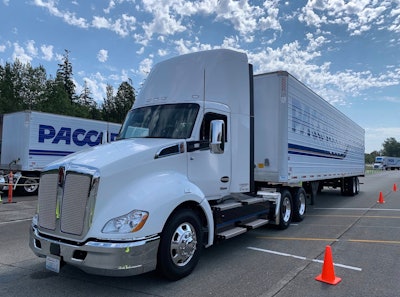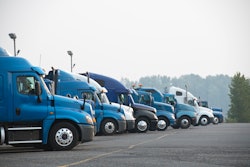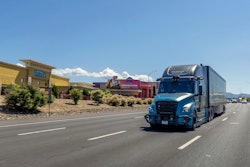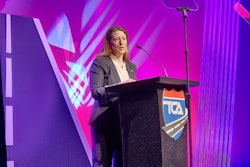
In a statement released by the White House, the EPA is seeking a technology-neutral approach that by 2032 could electrify 67% of new light-duty cars and trucks as well as electrifying 50% of vocational vehicles like buses and waste haulers; 35% of new short-haul regional tractors; and 25% of new long-haul trucks.
[Related: Report says Hydrogen will emerge as zero emission solution for long-haul trucking]
While these standards are directed at manufacturers, American Trucking Associations President and CEO Chris Spear said it is fleets – the customers and end-users of this equipment – who will ultimately determine their level of success. "The Phase 3 standards must take into account the complex challenges and operating conditions facing motor carriers as we manage the transition to a zero-emission future while simultaneously moving more than 72% of the economy’s freight," he said.
The White House reports that the EPA’s approach to slashing emissions, termed the Clean Vehicle Transition in Technology-Neutral Way, envisions using more clean-running gas vehicles, hybrids, fuel cell vehicles and other innovations to meet stricter standards.
However, the Biden administration goes on to say, “with EV technology getting better and cheaper every day, and consumer demand rising rapidly, many manufacturers would likely rely on fully electric vehicles for compliance.”
[Related: California now requiring all-electric trucks]
Truck and Engine Manufacturing Association President Jed R. Mandel said the non-profit group which represents major OEMs around the globe is currently reviewing the EPA’s proposed changes and offered support in the interim.
“EMA and its member companies have a long history of working with EPA on the development and implementation of stringent regulations that have greatly reduced GHG and other harmful emissions from heavy-duty vehicles,” Mandel said. “We look forward to engaging with EPA and providing data and insights to inform a comprehensive final rule that will successfully accelerate the adoption of heavy-duty ZEVs.”
John Boesel, President and CEO of CALSTART, a California-based non-profit that advocates for emissions reductions in transportation across the country, applauded the EPA’s efforts.
“The rules proposed by the EPA today build on the historic investments of the Inflation Reduction Act, continuing the Administration’s leadership in supporting the transition to a zero-emission transportation future, improving public health and addressing the climate crisis,” Boesel said.
Spear noted his disappointment that EPA has chosen to reopen its Phase 2 regulation, which had been set for years. "To make the plans and investments necessary for a successful transition, our industry needs regulatory certainty, not whimsical changes of mind from year to year," he said. "Our industry has always found ways to partner with EPA on regulations that are tough but achievable. If EPA wants us to remain a willing participant, their going back and changing what was already agreed upon is not how to do it.”
Todd Spencer, president of the Owner-Operator Independent Drivers Association, said the Biden administration’s shift to zero emissions adds additional strain to small business owners who at this point can’t see an electric truck measuring up in such a demanding industry.
“The Biden-Harris EPA is continuing their regulatory blitz on small-business truckers” Spencer said. “Professional drivers are skeptical of EV costs, mileage range, battery weight and safety, charging time, and availability. It’s baffling that the EPA is pushing forward with more impractical emissions timelines without first addressing these overwhelming concerns with electric CMVs. The pursuit of this radical environmental agenda in conjunction with an anticipated speed limiter mandate will regulate the safest and most experienced truckers off the road.”
Supply chain impact, the rush to buy ICE
A push to build additional EVs will not strain lithium supplies, according to Ann Rundle, vice president or electrification and autonomy at ACT Research. Lithium is one of the major elements used to build EV batteries.“There's lots of lithium on terra firma,” said Rundle who has been working on ACT’s upcoming decarbonization study, its third edition. “You do not have to go to the ocean and scrape the bottom floor and mess up the ecosystem of the ocean.
“We're hardly tapping what is in world reserves, much less world resources and the amount of lithium, either lithium extraction sites today that are expanding and or new sites that are happening is incredible.”
However, Rundle was not sure of how the Biden administration’s vehicle electrification strategy would impact the microchip supply chain. EVs require more microchips than internal combustion vehicles, she said.
[Related: 'Massive tailwind' from renewable natural gas]
Daniel Gage, president of Natural Gas Vehicles for America, said that while NGVA supports the Biden Administration’s move to reduce emissions, the non-profit has concerns over EV supply chain issues. NGVA and other natural gas proponents support using renewable natural gas (RNG) which the California Air Resources Board and the EPA recognize as having the lowest carbon intensity value among all transportation fuels.
“Battery electric vehicle technologies face numerous hurdles… hurdles that do not exist for RNG-fueled vehicles,” Gage said. “RNG is a domestic fuel, harvestable in all 50 U.S. states without reliance on conflict regions and mining around the globe. We have a nationwide networks of established fuelers (and dispensers), suppliers, and service providers. And our vehicle technology is proven, affordable, and scalable for all commercial applications today.”
Karl Brauer, executive analyst at iSeeCars, pointed to current supply chain issues hampering EV production.
“The current global supply chain is absolutely not able to produce EVs at the same rate it produces gasoline vehicles,” Brauer said. “This might be addressed over time, but there are concerns that the amount of time, energy, and cost required to produce an EV’s battery pack is unsustainable at a large, global level — at least in the volumes necessary to address personal transportation needs.
“The Inflation Reduction Act is encouraging more EV and battery production in North America, but it will take several years to develop and implement those manufacturing resources. I can’t imagine them being in place in the timeframe required by the latest EV sales standards,” Brauer said.
Brauer also cautioned that the push to electrification could result in higher prices for conventional fuels like diesel and gasoline.
“Fuel prices are another concern,” Brauer said. “The government could simply tax gasoline and diesel so aggressively people can’t afford to fill up their traditional vehicles. This uncertainty is among the most concerning aspects of the effort to push EVs.”
The White House stated that both public and private funding have continued to grow as vehicle electrification efforts expand.
In addition to $120 billion raised in private investment for EV and battery production in the U.S. since Biden took office, the administration pointed to $25 billion raised through the Bipartisan Infrastructure Law to support clean transportation including charger deployment; $6 billion through the Inflation Reduction Act to support OEMs in transitioning to manufacturing clean vehicles as well as funding the deployment of clean heavy-duty vehicles across the country.
Rundle and Brauer both agree that the push for greater vehicle electrification could result in surging sales of internal combustion vehicles.
“There could be a sense of ‘buy the ICE vehicle you want while you still can’ with these rules, but the flip side will be concern over what restrictions ICE vehicles might soon face,” Brauer said. “There are already sections of London where you can’t drive an ICE vehicle, and I could see those policies coming here to encourage people keeping their older cars to get rid of them.”












